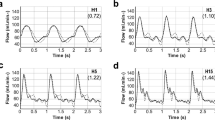Abstract
Background
To evaluate the haemodynamic changes induced by flow diversion treatment in cerebral aneurysms, resulting in thrombosis or persisting aneurysm patency over time.
Method
Eight patients with aneurysms at the para-ophthalmic segment of the internal carotid artery were treated by flow diversion only. The clinical follow-up ranged between 6 days and 12 months. Computational fluid dynamics (CFD) analysis of pre- and post-treatment conditions was performed in all cases. True geometric models of the flow diverter were created and placed over the neck of the aneurysms by using a virtual stent-deployment technique, and the device was simulated as a true physical barrier. Pre- and post-treatment haemodynamics were compared, including mean and maximal velocities, wall-shear stress (WSS) and intra-aneurysmal flow patterns. The CFD study results were then correlated to angiographic follow-up studies.
Results
Mean intra-aneurysmal flow velocities and WSS were significantly reduced in all aneurysms. Changes in flow patterns were recorded in only one case. Seven of eight aneurysms showed complete occlusion during the follow-up. One aneurysm remaining patent after 1 year showed no change in flow patterns. One aneurysm rupturing 5 days after treatment showed also no change in flow pattern, and no change in the maximal inflow velocity.
Conclusions
Relative flow velocity and WSS reduction in and of itself may result in aneurysm thrombosis in the majority of cases. Flow reductions under aneurysm–specific thresholds may, however, be the reason why some aneurysms remain completely or partially patent after flow diversion.


Similar content being viewed by others
References
Aird WC (2007) Vascular bed-specific thrombosis. J Thromb Haemost 5(Suppl 1):283–291
Augsburger L, Reymond P, Rufenacht DA, Stergiopulos N (2011) Intracranial stents being modeled as a porous medium: flow simulation in stented cerebral aneurysms. Ann Biomed Eng 39(2):850–863
Byrne JV, Beltechi R, Yarnold JA, Birks J, Kamran M (2010) Early experience in the treatment of intra-cranial aneurysms by endovascular flow diversion: a multicentre prospective study. PLoS One 5(9).pii: e12492
Cebral JR, Mut F, Raschi M, Scrivano E, Ceratto R, Lylyk P, Putman CM (2011) Aneurysm rupture following treatment with flow-diverting stents: computational hemodynamics analysis of treatment. AJNR Am J Neuroradiol 32(1):27–33
Frösen J, Piippo A, Paetau A, Kangasniemi M, Niemelä M, Hernesniemi J, Jääskeläinen J (2004) Remodeling of saccular cerebral artery aneurysm wall is associated with rupture: histological analysis of 24 unruptured and 42 ruptured cases. Stroke 35(10):2287–2293
Kataoka K, Taneda M, Asai T, Kinoshita A, Ito M, Kuroda R (1999) Structural fragility and inflammatory response of ruptured cerebral aneurysms. A comparative study between ruptured and unruptured cerebral aneurysms. Stroke 30(7):1396–1401
Kulcsár Z, Ernemann U, Wetzel SG, Bock A, Goericke S, Panagiotopoulos V, Forsting M, Ruefenacht DA, Wanke I (2010) High-profile flow diverter (silk) implantation in the basilar artery: efficacy in the treatment of aneurysms and the role of the perforators. Stroke 41(8):1690–1696
Kulcsár Z, Houdart E, Bonafé A, Parker G, Millar J, Goddard AJ, Renowden S, Gál G, Turowski B, Mitchell K, Gray F, Rodriguez M, van den Berg R, Gruber A, Desal H, Wanke I, Rüfenacht DA (2011) Intra-aneurysmal thrombosis as a possible cause of delayed aneurysm rupture after flow-diversion treatment. AJNR Am J Neuroradiol 32(1):20–25
Lylyk P, Miranda C, Ceratto R, Ferrario A, Scrivano E, Luna HR, Berez AL, Tran Q, Nelson PK, Fiorella D (2009) Curative endovascular reconstruction of cerebral aneurysms with the pipeline embolization device: the Buenos Aires experience. Neurosurgery 64(4):632–642, discussion 642-3; quiz N6
Nelson PK, Lylyk P, Szikora I, Wetzel SG, Wanke I, Fiorella D (2011) The pipeline embolization device for the intracranial treatment of aneurysms trial. AJNR Am J Neuroradiol 32(1):34–40
Reymond P, Merenda F, Perren F, Rüfenacht D, Stergiopulos N (2009) Validation of a one-dimensional model of the systemic arterial tree. Am J Physiol Heart Circ Physiol 297(1):H208–H222
Sadasivan C, Cesar L, Seong J, Rakian A, Hao Q, Tio FO, Wakhloo AK, Lieber BB (2009) An original flow diversion device for the treatment of intracranial aneurysms: evaluation in the rabbit elastase-induced model. Stroke 40(3):952–958
Szikora I, Berentei Z, Kulcsar Z, Marosfoi M, Vajda ZS, Lee W, Berez A, Nelson PK (2010) Treatment of intracranial aneurysms by functional reconstruction of the parent artery: the Budapest experience with the pipeline embolization device. AJNR Am J Neuroradiol 31(6):1139–1147
Ujiie H, Tamano Y, Sasaki K, Hori T (2001) Is the aspect ratio a reliable index for predicting the rupture of a saccular aneurysm? Neurosurgery 48(3):495–502, discussion 502-3
Wiebers DO, Whisnant JP, Huston J, Meissner I, Brown RD, Piepgras DG, Forbes GS, Thielen K, Nichols D, O’Fallon WM, Peacock J, Jaeger L, Kassell NF, Kongable-Beckman GL, Torner JC, International Study of Unruptured Intracranial Aneurysms Investigators (2003) Unruptured intracranial aneurysms: natural history, clinical outcome, and risks of surgical and endovascular treatment. Lancet 362(9378):103–110
Acknowledgments
This work was partially supported by a grant from the Swiss National Science Foundation (SNSF) (CR32I3-127008). The CFD studies were partially financed by Balt International.
Conflicts of interest
Z. Kulcsar and I. Wanke are contractual proctors for Silk FD implantation with Balt Int.
Author information
Authors and Affiliations
Corresponding author
Rights and permissions
About this article
Cite this article
Kulcsár, Z., Augsburger, L., Reymond, P. et al. Flow diversion treatment: intra-aneurismal blood flow velocity and WSS reduction are parameters to predict aneurysm thrombosis. Acta Neurochir 154, 1827–1834 (2012). https://doi.org/10.1007/s00701-012-1482-2
Received:
Accepted:
Published:
Issue Date:
DOI: https://doi.org/10.1007/s00701-012-1482-2




